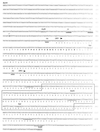Neisseria gonorrhoeae mutants altered in toxicity to human fallopian tubes and molecular characterization of the genetic locus involved
- PMID: 9916071
- PMCID: PMC96367
- DOI: 10.1128/IAI.67.2.643-652.1999
Neisseria gonorrhoeae mutants altered in toxicity to human fallopian tubes and molecular characterization of the genetic locus involved
Abstract
In an effort to identify potential cytotoxins expressed by Neisseria gonorrhoeae, we have identified a locus that, when mutated in the gonococcus, results in a significant increase in toxicity of the strain to human fallopian tube organ cultures (HFTOC). This locus, gly1, contains two open reading frames (ORFs) which are likely cotranscribed. ORF1 encodes a polypeptide of 17.8 kDa with a signal sequence that is recognized and processed in Escherichia coli and N. gonorrhoeae. The 15.6-kDa processed polypeptide has been observed in membrane fractions and filtered spent media from cultures of E. coli expressing gly1 and in outer membrane preparations of wild-type N. gonorrhoeae. The gly1 locus is not essential for bacterial survival, and it does not play a detectable role in epithelial cell adhesion, invasion, or intracellular survival. However, a gly1 null mutant causes much more damage to fallopian tube tissues than its isogenic wild-type parent. A strain complemented in trans for the gly1 mutation showed a level of toxicity to HFTOC similar to the level elicited by the wild-type parent. Taken together, these results indicate an involvement of the gly1 locus in the toxicity of N. gonorrhoeae to human fallopian tubes.
Figures






References
-
- Altschul S F, Gish W, Miller W, Myers E W, Lipman D J. Basic local alignment search tool. J Mol Biol. 1990;215:403–410. - PubMed
-
- Arvidson, C. G., and M. So. Unpublished data.
-
- Beale S I. Biosynthesis of hemes. In: Neidhardt F C, Curtiss III R, Ingraham J L, Lin E C C, Low K B, Magasanik B, Reznikoff W S, Riley M, Schaechter M, Umbarger H E, editors. Escherichia coli and Salmonella: cellular and molecular biology. Washington, D.C: American Society for Microbiology; 1996. pp. 731–748.
-
- Bernheimer A W. Assay of hemolytic toxins. Methods Enzymol. 1988;165:213–217. - PubMed
-
- Brown N M, Ragge N K, Speller D C. Septicaemia due to Neisseria lactamica—initial confusion with Neisseria meningitidis. J Infect Dis. 1987;15:243–245. - PubMed
Publication types
MeSH terms
Substances
Associated data
- Actions
Grants and funding
LinkOut - more resources
Full Text Sources
Other Literature Sources
Research Materials

